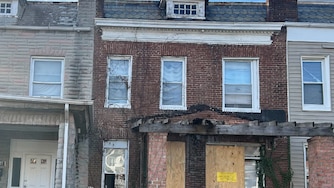When Baltimore city officials arrived at work on Wednesday morning, they found 17 red tents neatly arranged on the grassy plaza across from City Hall.
Advocates erected the encampment early Wednesday to draw attention to the city’s homelessness crisis and to the encampments they say are popping up across Baltimore.
“They got all this funding but they’re not doing the proper thing with it,” said Alonzo Coley, a leader with the organization Voices of the Homeless, referring to more than $90 million in federal funds that Mayor Brandon Scott announced the city would receive for homeless services.
“Where’s the money going? Why is it not helping people?” asked Coley, who manned a donations table on the plaza’s perimeter, with a list of demands titled “housing is a right” propped up against it.
The funds, most of which were provided through the American Rescue Plan and the rest through the U.S. Department of Housing and Urban Development, will begin flowing to certain programs in the coming weeks, said Jack French, a spokesperson for the mayor. Funding for other programs has yet to be approved by the Board of Estimates.

Advocates for homeless people erected a “tent city” in the same spot in 2017, said Christina Flowers of the Belvedere Real Care Providers Network. Homeless people slept there for more than a week.
But Flowers said the concerns raised by advocates five years ago remain unaddressed by the city. Officials need to prioritize ongoing support to people discharged from shelters or hospitals, she said.
“You can’t just send them out to the wolves,” said Flowers, recalling the case of a patient who was discharged from the University of Maryland Medical Center and found on the street in only a hospital gown and socks in January 2018. “The system is failing the main individuals that they should be servicing.”
Coley has been homeless for two years, after an accident left him unable to continue working as a trucker and construction worker.
Early in the pandemic, he received temporary housing in an emergency shelter set up by the city at a hotel. But after his allotted time there ended, he said, he wasn’t provided with adequate options for additional shelter.
He isn’t eligible for programs available for people dealing with drug addiction. And many shelters require residents to be in the shelter by a certain time of night, which Coley said his child care responsibilities — he has a child who lives outside of the city — make it difficult to comply with.
Instead, he’s been sleeping in his car.
“I’m on waiting lists for everything and it’s just — nothing’s happening,” Coley said.
Inadequate tracking of unhoused people and limited shelter options have forced many people to seek shelter in tent encampments located under bridges and in city parks. There are more than 10 homeless encampments in Baltimore, according to organizers of the tent protest. They say the encampments are plagued by unsanitary conditions, a lack of drinkable water, COVID-19 outbreaks, and the risk of theft and sexual assault.
On Wednesday morning, people experiencing homelessness gathered around the edge of the plaza. Shanae Burke had used a black Sharpie to mark one of the tents with her nickname, 6, and placed spare clothes inside.
Burke became homeless after a nonprofit housing group that was supposed to pay her rent failed to do so, leading her landlord to evict her, she said.
She’s been sleeping in parks most nights since, but often feels unsafe there around people struggling with mental illness. She avoids shelters because of the risk of the coronavirus, which can spread easily through the air.
Burke participated in the 2017 encampment at City Hall, too, and hopes that this iteration will help draw attention to the challenges she and other homeless people face.
“It was eye-opening, it was like bringing people from across the globe to actually see what’s really going on,” Burke said.
Deputy Mayor Faith Leach went to the plaza to hear from homeless people and advocates. The city, Leach explained, was working to meet their demands.
“We all acknowledge that there are gaps in our system that have for far too long existed,” Leach said.
The additional $90 million allocated for homeless services, along with another $100 million in federal funds provided to address vacant housing and creating affordable housing initiatives, will help close these gaps, she said. In March, the mayor’s office released a strategic plan for how federal and other funding sources would be used to strengthen the city government’s response, including providing re-housing support for people in temporary COVID-19 shelters, expanding permanent supportive housing and investing in homeless diversion programs.
But advocates said these measures aren’t addressing the immediate crisis in front of them every day.
“We call the city to get these people relief, nobody answers the phone,” said Yolanda Pulley, an advocate with the local nonprofit People Empowered By The Struggle. “We call cell phones, we call this number, that number, it’s just one big circle going around and around. And nobody is helping them.”
Pulley emphasized that more affordable housing is needed to address the root cause of the crisis.
With rents increasing across the city and the pace of evictions rising — an eviction moratorium and court delays had slowed them early in the pandemic — Pulley said the homelessness problem is reaching a fever pitch that’s worse than she’s seen in her 20 years advocating for homeless people.
“We’re all one step away from homelessness,” Pulley said. “If we don’t create some relief for somebody, we’re going to be (the ones) in these tents next.”
sophie.kasakove@thebaltimorebanner.com
Read more:





Comments
Welcome to The Banner's subscriber-only commenting community. Please review our community guidelines.